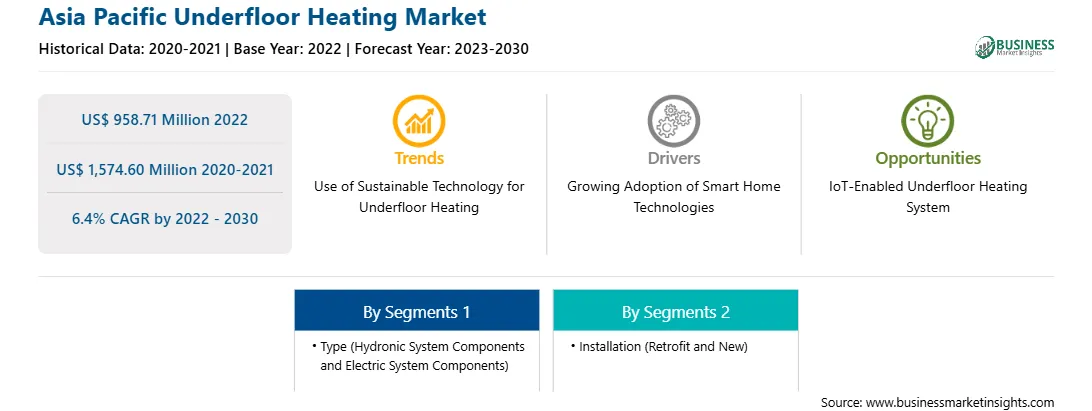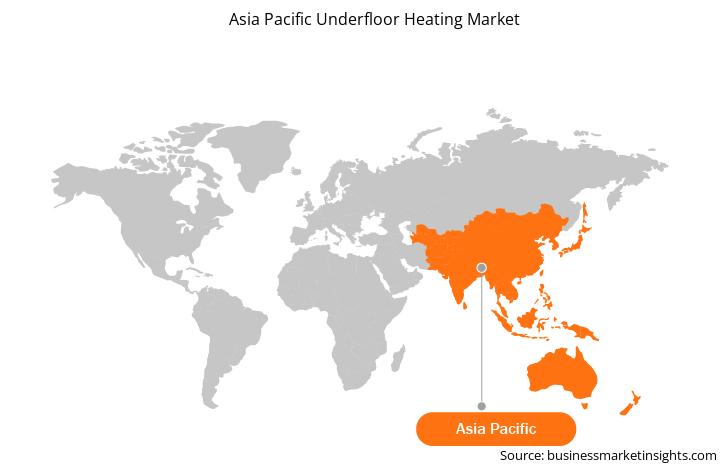The Asia Pacific underfloor heating market was valued at US$ 958.71 million in 2022 and is expected to reach US$ 1,574.60 million by 2030; it is estimated to register a CAGR of 6.4% from 2022 to 2030. Growing Use of Energy-Efficient Underfloor Heating System Boosts Asia Pacific Underfloor Heating Market.
Underfloor heating works by heating the floor and the objects on it radiate heat into the room. This creates an even more consistent temperature, meaning less energy is required to keep the room warm. In fact, underfloor heating can be up to 25% more efficient than traditional heating systems, resulting in lower energy bills and an eco-friendlier home. Traditional radiators should be heated to a high temperature (between 65 and 75 degrees Celsius) in order to heat a room efficiently. In contrast, floor heating requires just a temperature of 29 degrees Celsius or less, depending on the floor finish, to warm the room. Lower temperatures use less energy and can help to save money on energy costs.
Water-based underfloor heating systems use low water temperatures and cost ~60% less to operate than electric systems. Rapid response systems can also be installed beneath the floor finish, providing optimum control and making them suitable for retrofit or newbuild projects. One big benefit of using a water-based underfloor heating system is that hydrogen, gas boiler, or heat pump, water-based underfloor heating will always remain the most energy-efficient solution, use the least energy, and will assist in saving money, and delivering comfort. Thus, the growing use of energy-efficient heating systems will most likely create opportunities for the underfloor heating market.Asia Pacific Underfloor Heating Market Overview
The temperature in the Asia Pacific varies from the hottest to the coldest season. Due to urbanization, there are also significant development activities, such as the building of new structures and the renovation of old ones, especially in countries such as China, India, Japan, and Australia. Therefore, heating systems are designed for each particular building, office and business construction, sports hall, open areas, and industrial buildings. When it comes to cutting-edge and contemporary system solutions, building planners and owners have established their preferences for underfloor heating systems. Underfloor heating system installations have increased as a result of the trend toward smart solutions, luxury lifestyles, and convenience, in which the operation of these systems is regulated by routine consumption patterns and connected devices.
According to a report from the International Energy Agency, China has the largest workforce installing heat pumps and the largest market share in manufacturing heat pumps. Clean heating in China has been driven by the country's use of policies enforcing technology mandates, such as its clean winter heat plan in northern China and its electric heating policy, which requires the substitution of coal-fired heating with electric heating19. These efforts have been bolstered by local financial incentives, such as in Beijing, that support heat pump deployment. China is the world's largest market for air-source heat pumps, and sales grew ~7% to reach 12.5 million units in 2021. Thus, policies such as clean winter will propel the adoption of underfloor heating systems in the region.
Several countries in Asia Pacific are inclined toward the conservation of energy and the use of energy-efficient technologies. For example, as of July 2015, the Ministry of Economy, Trade and Industry (METI) established a subcommittee on the long-longstanding energy supply and demand outlook to deliberate the energy mix for Japan with a view to change Japan's energy mix by 2030. The establishment of the subcommittee is expected to boost energy conservation and better energy management by the household sector. For that, the government of Japan introduced smart home technology to conserve energy, which can contribute to household sector savings. The smart house favors energy consumption and is optimized by the application of information technology (IT). It controls energy-generating equipment, such as heating and air conditioning, that are capable of communicating with one another. Thus, the adoption of smart home technology in Japan will propel the growth of the Asia Pacific underfloor heating market.
Asia Pacific Underfloor Heating Market Revenue and Forecast to 2030 (US$ Million)
Strategic insights for the Asia Pacific Underfloor Heating provides data-driven analysis of the industry landscape, including current trends, key players, and regional nuances. These insights offer actionable recommendations, enabling readers to differentiate themselves from competitors by identifying untapped segments or developing unique value propositions. Leveraging data analytics, these insights help industry players anticipate the market shifts, whether investors, manufacturers, or other stakeholders. A future-oriented perspective is essential, helping stakeholders anticipate market shifts and position themselves for long-term success in this dynamic region. Ultimately, effective strategic insights empower readers to make informed decisions that drive profitability and achieve their business objectives within the market. The geographic scope of the Asia Pacific Underfloor Heating refers to the specific areas in which a business operates and competes. Understanding local distinctions, such as diverse consumer preferences (e.g., demand for specific plug types or battery backup durations), varying economic conditions, and regulatory environments, is crucial for tailoring strategies to specific markets. Businesses can expand their reach by identifying underserved areas or adapting their offerings to meet local demands. A clear market focus allows for more effective resource allocation, targeted marketing campaigns, and better positioning against local competitors, ultimately driving growth in those targeted areas.Asia Pacific Underfloor Heating Strategic Insights

Asia Pacific Underfloor Heating Report Scope
Report Attribute
Details
Market size in 2022
US$ 958.71 Million
Market Size by 2030
US$ 1,574.60 Million
Global CAGR (2022 - 2030)
6.4%
Historical Data
2020-2021
Forecast period
2023-2030
Segments Covered
By Type
By Installation
Regions and Countries Covered
Asia-Pacific
Market leaders and key company profiles
Asia Pacific Underfloor Heating Regional Insights

Asia Pacific Underfloor Heating Market Segmentation
The Asia Pacific underfloor heating market is segmented based on type, installations, application, and country. Based on type, the Asia Pacific underfloor heating market is bifurcated into hydronic system components and electric system components. The hydronic system components services held a larger market share in 2022. The hydronic system components is sub segmented into wet hydronic heating and dry hydronic heating. Furthermore, electric system components is bifurcated into heating mats and heating cables.
In terms of installation, the Asia Pacific underfloor heating market is bifurcated into retrofit and new. The retrofit held a larger market share in 2022.
By application, the Asia Pacific underfloor heating market is bifurcated into residential & commercial. The residential held a larger market share in 2022.
Based on country, the Asia Pacific underfloor heating market is segmented into Japan, South Korea, China, Australia, India, and the Rest of Asia Pacific. Japan dominated the Asia Pacific underfloor heating market share in 2022.
Danfoss AS, Emerson Electric Co, nVent Electric Plc, Watts Water Technologies Inc, Robert Bosch GmbH, Resideo Technologies Inc, Uponor Corp, REHAU Ltd, and Schneider Electric SE are some of the leading companies operating in the Asia Pacific underfloor heating market.
1. Danfoss AS.
2. Emerson Electric Co.
3. nVent Electric Plc.
4. Watts Water Technologies Inc.
5. Robert Bosch GmbH.
6. Resideo Technologies Inc.
7. Uponor Corp.
8. REHAU Ltd.
9. Schneider Electric SE.
The Asia Pacific Underfloor Heating Market is valued at US$ 958.71 Million in 2022, it is projected to reach US$ 1,574.60 Million by 2030.
As per our report Asia Pacific Underfloor Heating Market, the market size is valued at US$ 958.71 Million in 2022, projecting it to reach US$ 1,574.60 Million by 2030. This translates to a CAGR of approximately 6.4% during the forecast period.
The Asia Pacific Underfloor Heating Market report typically cover these key segments-
The historic period, base year, and forecast period can vary slightly depending on the specific market research report. However, for the Asia Pacific Underfloor Heating Market report:
The Asia Pacific Underfloor Heating Market is populated by several key players, each contributing to its growth and innovation. Some of the major players include:
The Asia Pacific Underfloor Heating Market report is valuable for diverse stakeholders, including:
Essentially, anyone involved in or considering involvement in the Asia Pacific Underfloor Heating Market value chain can benefit from the information contained in a comprehensive market report.